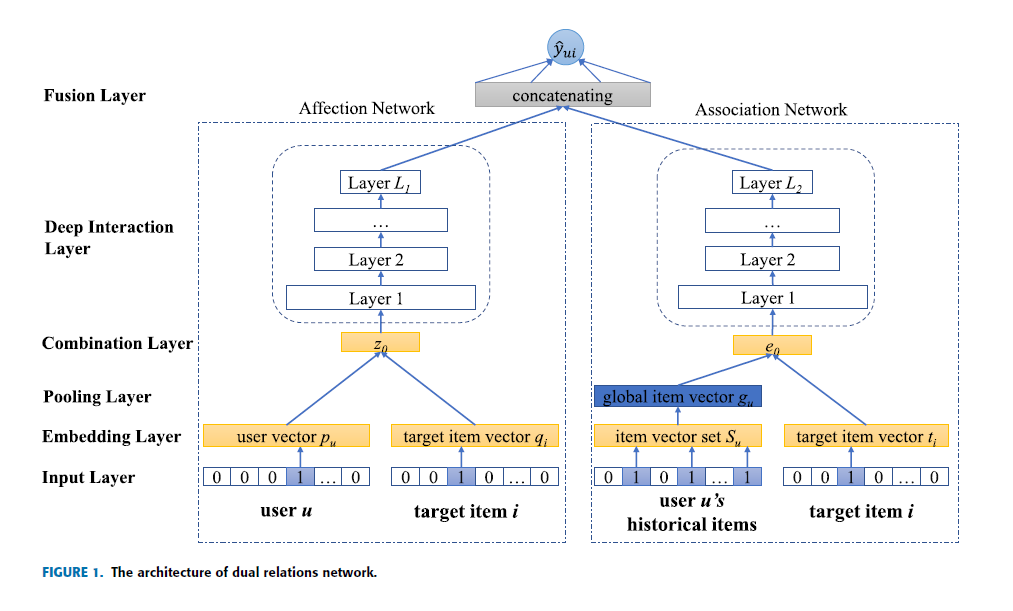Semi-Dual Embedding based Latent Factor Model
Based on the following lectures
(1) “Recommendation System Design (2024-1)” by Prof. Ha Myung Park, Dept. of Artificial Intelligence. College of SW, Kookmin Univ.
(2) "Recommender System (2024-2)" by Prof. Hyun Sil Moon, Dept. of Data Science, The Grad. School, Kookmin Univ.
DRNet
- 문제 의식
- 기존 협업 필터링이 모델링하는 관계 유형
- 잠재요인 모형(Latent Factor Model): 사용자-아이템 관계 모델링, 개인화 추천 성능 우수 (ex.
NCF) - 아이템 기반 협업 필터링(User Free Model): 아이템-아이템 관계 모델링, 데이터 희소성 강건 (ex.
SLIM,FISM)
- 잠재요인 모형(Latent Factor Model): 사용자-아이템 관계 모델링, 개인화 추천 성능 우수 (ex.
- 어텐션 기반 히스토리 아이템 집계 방식 (ex.
NAIS)- 사용자가 과거에 더 선호한 아이템일수록 새로운 아이템 선택에 더 큰 영향력을 행사함
- 사용자의 선호 정도에 기반하여 집중도를 차등 부여하여 집계할 필요가 있음
- 기존 협업 필터링이 모델링하는 관계 유형
DRNet(DualRelationNet-work) : 사용자-아이템 매칭 함수와 아이템-아이템 매칭 함수를 병렬 학습하는 모형- Ji, D., Xiang, Z., & Li, Y.
(2020).
Dual relations network for collaborative filtering.
IEEE Access, 8, 109747-109757.
- Ji, D., Xiang, Z., & Li, Y.
- Components
- Affection Network: Modeling User-Item Relation
- Association Network: Modeling Item-Item Relation
- Dual-Relation Network: Affection Network & Association Network Combination
Notation
- $u=1,2,\cdots,M$: user idx
- $i=1,2,\cdots,N$: item idx
- $\mathbf{Y} \in \mathbb{R}^{M \times N}$: user-item interaction matrix
- $\overrightarrow{\mathbf{u}}_{u} \in \mathbb{R}^{K}$: user id embedding vector @ affection network
- $\overrightarrow{\mathbf{v}}_{i} \in \mathbb{R}^{K}$: item id embedding vector @ affection network
- $\overrightarrow{\mathbf{p}}_{i} \in \mathbb{R}^{K}$: target item id embedding vector @ association network
- $\overrightarrow{\mathbf{q}}_{j} \in \mathbb{R}^{K}$: history item id embedding vector @ association network
- $\overrightarrow{\mathbf{z}}_{u,i}$: predictive vector of user $u$ and item $i$
- $\hat{y}_{u,i}$: interaction probability of user $u$ and item $i$
How to Modeling
-
Dual-Relation Network:
\[\begin{aligned} \hat{y}_{u,i} &= \sigma\left(\overrightarrow{\mathbf{w}} \cdot [\overrightarrow{\mathbf{z}}_{u,i}^{\text{(AFFECT)}} \oplus \overrightarrow{\mathbf{z}}_{u,i}^{\text{(ASSO)}}]\right) \end{aligned}\]
Affection Network
-
ID Embedding:
\[\begin{aligned} \overrightarrow{\mathbf{u}}_{u} &= \text{Emb}(u)\\ \overrightarrow{\mathbf{v}}_{i} &= \text{Emb}(i) \end{aligned}\] -
Predictive Vector of user $u$ and item $i$:
\[\begin{aligned} \overrightarrow{\mathbf{z}}_{u,i} &= \text{MLP}_{\text{ReLU}}(\overrightarrow{\mathbf{u}}_{u} \odot \overrightarrow{\mathbf{v}}_{i}) \end{aligned}\]
Association Network
-
ID Embedding:
\[\begin{aligned} \overrightarrow{\mathbf{p}}_{i} &= \text{Emb}(i)\\ \overrightarrow{\mathbf{q}}_{j} &= \text{Emb}(j) \end{aligned}\] -
Global Item Vector of User $u$:
\[\begin{aligned} \overrightarrow{\mathbf{x}}_{u} &= \text{ATTN}(\overrightarrow{\mathbf{h}},\text{Affection}(u,\forall j \in \mathcal{R}_{u}^{+} \setminus \{i\}), \mathbf{Q}[\forall j \in \mathcal{R}_{u}^{+} \setminus \{i\},:]) \end{aligned}\] -
Predictive Vector of user $u$ and item $i$:
\[\begin{aligned} \overrightarrow{\mathbf{z}}_{u,i} &= \text{MLP}_{\text{ReLU}}(\overrightarrow{\mathbf{x}}_{u} \odot \overrightarrow{\mathbf{p}}_{i}) \end{aligned}\]
How to Attention
-
Query Vector is Global Context Vector:
\[\begin{aligned} \overrightarrow{\mathbf{h}} \end{aligned}\] -
Key Vector is Generated by Affection Network:
\[\begin{aligned} \overrightarrow{\mathbf{z}}_{u,i}^{\text{(AFFECT)}} &= \text{MLP}_{\text{ReLU}}(\overrightarrow{\mathbf{u}}_{u} \odot \overrightarrow{\mathbf{v}}_{i}) \end{aligned}\] -
Global Item Vector of User $u$ is Generated by:
\[\begin{aligned} \overrightarrow{\mathbf{x}}_{u} &= \sum_{j \in \mathcal{R}_{u}^{+} \setminus \{i\}}{\alpha_{u,j} \cdot \overrightarrow{\mathbf{q}}_{j}} \end{aligned}\] -
Attention Weight is Calculated by Smoothed Softmax:
\[\begin{aligned} \alpha_{u,j} &= \frac{\exp{f(\overrightarrow{\mathbf{h}},\overrightarrow{\mathbf{z}}_{u,j}^{\text{(AFFECT)}})}}{\left[\sum_{j \in \mathcal{R}_{u}^{+} \setminus \{i\}}{\exp{f(\overrightarrow{\mathbf{h}},\overrightarrow{\mathbf{z}}_{u,j}^{\text{(AFFECT)}})}}\right]^{\beta}} \end{aligned}\]- $0 < \beta \le 1$: Smoothing Factor
-
Attention Score Function is Dot Product:
\[\begin{aligned} f(q,k) &= q \cdot k \end{aligned}\]
This post is licensed under
CC BY 4.0
by the author.

